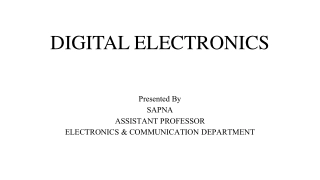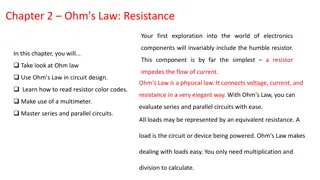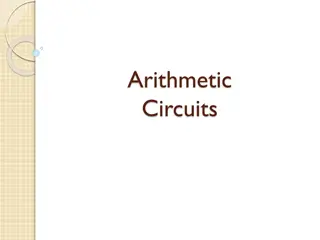Understanding Decoders in Digital Electronics
Decoders play a vital role in digital electronics by converting coded inputs into meaningful outputs. They are essential for tasks like data multiplexing, memory address decoding, and driving displays. This summary provides insights into the working principles, applications, and types of decoders commonly used in electronic circuits.
Download Presentation

Please find below an Image/Link to download the presentation.
The content on the website is provided AS IS for your information and personal use only. It may not be sold, licensed, or shared on other websites without obtaining consent from the author. Download presentation by click this link. If you encounter any issues during the download, it is possible that the publisher has removed the file from their server.
E N D
Presentation Transcript
Decoder A decoder is a combinational circuit that converts information from n input lines to an 2nunique output lines. In digital electronics, a decoder can take the form of a multiple-input, multiple-output logic circuit that converts coded inputs into coded outputs, where the input and output codes are different e.g. n-to-2n , binary-coded decimal decoders. Decoding is necessary in applications such as data multiplexing, 7 segment display and memory address decoding.
Some Applications: Microprocessor memory system: selecting different banks of memory. Microprocessor I/O: Selecting different devices. Memory: Decoding memory addresses (e.g. in ROM). In our lab decoding the binary input to activate the LED segments so that the decimal number can be displayed.
The example decoder circuit would be an AND gate because the output of an AND gate is "High" (1) only when all its inputs are "High." Such output is called as "active High output". If instead of AND gate, the NAND gate is connected the output will be "Low" (0) only when all its inputs are "High". Such output is called as "active low output". A slightly more complex decoder would be the n-to-2ntype binary decoders. These types of decoders are combinational circuits that convert binary information from 'n' coded inputs to a maximum of 2n unique outputs. In case the 'n' bit coded information has unused bit combinations, the decoder may have less than 2n outputs. 2-to-4 decoder, 3-to-8 decoder or 4-to-16 decoder are other examples.
2-to-4 decoder The input to a decoder is parallel binary number and it is used to detect the presence of a particular binary number at the input. The output indicates presence or absence of specific number at the decoder input. Let us suppose that a logic network has 2 inputs A and B. They will give rise to 4 states A, A , B, B . The truth table for this decoder is shown below:
Block and Logic Diagram of 2:4 decoder For any input combination only one of the outputs is low and all others are high. The low value at the output represents the state of the input.
2 2- -to to- -4 4- -line DECODER with Enable line DECODER with Enable The decoder is enabled when E = 0. The output whose value = 0 represents the minterm is selected by inputs A and B. The decoder is inactive when E = 1 -> D0 D3 = 1 A Decoder with enable input is called a decoder/demultiplexer. Demultiplexer receives information from a single line and directs it to the output lines.
Decoder expansion Decoder expansion Combine two or more small decoders with enable inputs to form a larger decoder e.g. 3-to-8-line decoder constructed from two 2-to-4- line decoders. Decoder with enable input can function as demultiplexer.
3:8 decoder 3:8 decoder It uses all AND gates, and therefore, the outputs are active- high. For active- low outputs, NAND gates are used. It has 3 input lines and 8 output lines. It is also called as binary to octal decoder it takes a 3-bit binary input code and activates one of the 8(octal) outputs corresponding to that code
3:8 line decoder truth table and Logic Diagram
A 4 x 16 DECODER When w = 0, the top decoder is enabled and the bottom is disabled. Top decoder generates 8 minterms 0000 to 0111, while the bottom decoder outputs are 0 s. When w = 1, the top decoder is disabled and the bottom is enabled. Bottom decoder generates 8 minterms 1000 to 1111, while the top decoder outputs are 0 s.
Full-Adder using Decoder (x, y, z) = S(1,2,4,7) (x, y, z ) = S(3,5,6,7)
Encoder Encoder An encoder is a device, circuit, transducer, software program, algorithm or person that converts information from one format or code to another. The purpose of encoder is standardization, speed, secrecy, security, or saving space by shrinking size. Encoders are combinational logic circuits and they are exactly opposite of decoders. They accept one or more inputs and generate a multibit output code. Encoders perform exactly reverse operation than decoder. An encoder has M input and N output lines. Out of M input lines only one is activated at a time and produces equivalent code on output N lines. If a device output code has fewer bits than the input code has, the device is usually called an encoder.
Octal to binary encoder Octal-to-Binary take 8 inputs and provides 3 outputs, thus doing the opposite of what the 3-to-8 decoder does. At any one time, only one input line has a value of 1. The figure below shows the truth table of an Octal-to-binary encoder. Table 3: Truth Table of octal to binary encoder
Logic Diagram of octal to binary encoder For an 8-to-3 binary encoder with inputs z = D1 + D3 + D5 + D7 y = D2 + D3 + D6 + D7 x = D4 + D5 + D6 + D7 Or Y2 = I1 + I3 + I5 + I7 Y1= I2 + I3 + I6 + I7 Y0 = I4 + I5 + I6 +I7























